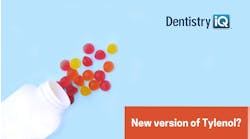Due to a series of recalls, snoring and sleep apnea patients all over the world have been forced to reconsider their options for treatment. They might find relief in speaking with their dentist. Here’s why.
In 2021 and 2022, the FDA announced three recalls on Philips ResMed CPAP and BiLevel machines, parts, and masks.1-3 It was estimated that 4 million patients were directly affected, but that number is multiplied when new orders and supply chain issues are considered.
CPAP (continuous positive airway pressure) therapy is extremely effective, and despite its indisputable low rate of compliance, it’s still considered the gold standard of treatment for obstructive sleep apnea (OSA). OSA is a sleep-related breathing disorder that causes snoring and also causes the airway to constrict and/or become completely blocked multiple times an hour during sleep. This doesn’t just cause an annoying snoring noise and a dry mouth in the morning; if left untreated, OSA can lead to cardiovascular disease and Alzheimer’s disease, among many other negative health outcomes.
You might also be interested in: Fitness tips that can improve your sleep, from a sleep expert
With multiple recalls affecting CPAP devices for treatment, patients are left with three options: continue treatment at their own risk, wait for a new or replacement device, or seek alternative options.
This is where dentists can save the day (and save lives)
Here are some options to share with your patients.
Oral appliance therapy
Oral appliance therapy (OAT) is an effective treatment option for many people with OSA, and it’s provided by trained dental professionals. This involves a custom-made device—sometimes called a mandibular advancement device (MAD)—that you wear at night to hold your jaw and tongue in a comfortable position, away from your airway during sleep.
If you were told you were not a candidate for OAT many years ago, think again. Quality manufacturers of oral appliances use new technology and materials to make devices to treat patients who have been diagnosed with mild to moderate sleep apnea … even if you are missing a few teeth! If you have been diagnosed with severe sleep apnea, CPAP is still your best option, but inability to tolerate or use the device may make you a candidate for OAT.
eXciteOSA
eXcite OSA4 is a newer treatment option that has been getting a lot of buzz lately. It is the only clinically proven daytime therapy for snoring and mild OSA. This is a device you wear in your mouth for just 20 minutes each day that helps retrain the upper airway and tongue, treating the root cause of snoring and apnea. It may also have utility for people with upper airway resistance syndrome (UARS), which is commonly seen in women and nonobese people. For the right person, eXciteOSA can be easy to use and effective, but consistency and daily use is key.
Myofunctional therapy
Lastly, you can’t talk about addressing the root cause of snoring and sleep apnea without mentioning myofunctional therapy. Done with the help of a specialist at the dentist’s office, this is a series of exercises and practices to strengthen your airway and tongue muscles, while also reducing mouth-breathing during wake and sleep. Some studies show a reduction in OSA symptoms and sleepiness when myofunctional therapy is combined with other treatment modalities.5
Hope for patients with OSA
Patients don’t have to wait and hope to reclaim their sleep health with a new CPAP. Encourage them to speak to their dentist or a credentialed sleep coach about these alternative treatment options.
Keep in mind that sleep apnea treatments and devices require a prescription from a physician. Patients who shop online or at a drugstore for alternatives are likely to be wasting their money. Make sure your patients take their health and sleep seriously by talking to a professional about treatment options. If you don’t know which one would be best, feel free to reach out to me for a recommendation.
Editor’s note: This article first appeared in Through the Loupes newsletter, a publication of the Endeavor Business Media Dental Group. Read more articles and subscribe to Through the Loupes.
References
- Certain Philips Respironics ventilators, BiPAP, and CPAP machines recalled due to potential health risks: FDA safety communication. U.S. Food & Drug Administration. June 30, 2021. Updated November 12, 2021. https://www.fda.gov/medical-devices/safety-communications/certain-philips-respironics-ventilators-bipap-and-cpap-machines-recalled-due-potential-health-risks
- Certain Philips Respironics BiPAP machines recalled due to a plastic issue: FDA safety communication. U.S. Food & Drug Administration. August 29, 2022. Updated December 6, 2022. https://www.fda.gov/medical-devices/safety-communications/certain-philips-respironics-bipap-machines-recalled-due-plastic-issue-fda-safety-communication#:~:text=Date%20Issued%3A%20August%2029%2C%202022&text=If%20that%20plastic%20is%20in,stop%20working%20suddenly%20during%20use
- Certain Philips Respironics masks for BiPAP, CPAP machines recalled due to safety issue with magnets that may affect certain medical devices: FDA safety communication. U.S. Food & Drug Administration. September 6, 2022. Updated October 19, 2022. https://www.fda.gov/medical-devices/safety-communications/certain-philips-respironics-masks-bipap-cpap-machines-recalled-due-safety-issue-magnets-may-affect
- eXciteOSA. www.exciteosa.com
- de Felício CM, da Silva Dias FV, Trawitzki LVV. Obstructive sleep apnea: focus on myofunctional therapy. Nat Sci Sleep. 2018;10:271-286. doi:10.2147/NSS.S141132






